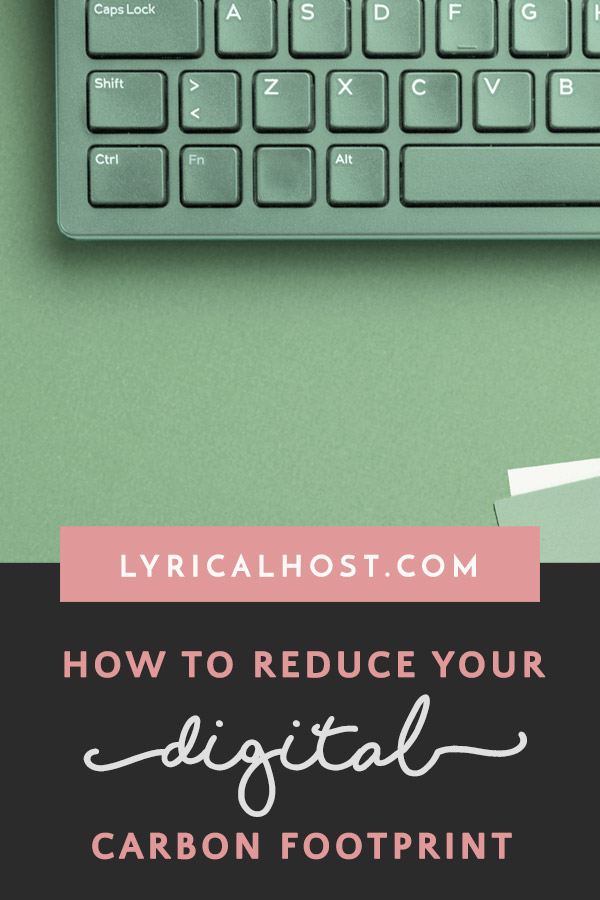There are a whole bunch of things in the world we can’t control, especially when it comes to the environment. But what we do have personal responsibility for can still make a much needed difference to the planet.
In this post we look at what you can do to reduce the impact your website, email and other digital habits have on the world. By the end of the post, you should have some inspiration for how you can be more green online, starting right away!
Currently reading: How to reduce your digital carbon footprint Click To Tweet
Before we get started listing some of the things you can do, we thought you may be interested in or take some inspiration from what we do. As a company, we have an environmental policy which details everything from the tree planting we do to our office recycling, which you can find on our About page. You can also find out more about the coral reef research and other non-profits we donate to on our Causes We Support page.
Tree planting & data centers with considered environmental impact, but what can you do personally
How does digital contribute to your carbon footprint? Everything from the electricity used to power the servers that host websites, to the electricity you use to view websites.
Below are some quick and simple changes you can make; don’t worry if you aren’t doing all of them, or aren’t doing all of them just yet – every little helps.
01. Optimize your web page sizes wherever possible
The smaller your images and pages are, the less web space and bandwidth needed to store and serve them, and the less energy needed for your visitors to view them. As servers run 24/7, you can save a surprising amount of electricity by making small changes that don’t compromise on user experience. For example, you can make your images as small as possible using our image optimization guide, or run a waterfall speed test to see the size of your pages and where you can make big quick wins. There’s more info on that in our guide to speed optimization, and if you’re a Lyrical Host customer, there’s a big free download in our Resource Library or you can reach out to our support team for help. A good page size for a WordPress website is less than 1.5MB, but the smaller the better!
As well as being greener, this also helps your website pages load faster, and saves people money if they’re viewing your content using pay-as-you-go data.
02. Keep your email signature simple
Lots of people favor fancy email signatures, with headshots, links, icons, messaging, and so on. Having a simple, text-based email signature will reduce the size of the emails you send, meaning more storage space is saved and less energy is used to send, store and receive.
Ironically,“Please consider the environment before printing this email” signatures may be worse for the environment than saying nothing at all.
03. Reduce the web space and bandwidth you use
For your website, this could be things like only lazy loading images and other content when your visitors scroll to see them, minmizing the use of full screen size images, only storing recent website backups (instead of all of them ever), deleting files you no longer need, going back and optimzing old content, not having super long/heavy download pages (and having zipped files for visitors to download instead), etc.
You can apply this tip everywhere you upload or view files, not just your website. For example, you could optimize your images before uploading to Instagram or Pinterest, and optimize videos using something like Handbrake even before uploading to YouTube or Vimeo.
When watching video yourself, you could opt for a lower quality stream. If you watch a lot of video, the savings quickly add up!
04. Optimize your files
As part of reducing your space and bandwidth, optimizing images, PDFs, videos and other large file types goes a long way to helping. This also helps for files you aren’t necessarily uploading to your website, but sending via email, uploading to cloud storage, sending via project management tools and other collaborative software, and so on.
If you create videos, Handbrake is a great compression tool that will dramatically reduce the size of your videos without compromising on quality. For more on compressing images, see our blog post on How To Optimize Images. For PDFs, check your PDF making software to see what options it provides for smaller file sizes when you hit “save.”
05. Reduce the energy your email newsletter uses
The more complex your email newsletter, the more energy it takes to send. Don’t forget to resize and optimize your images before adding them, consider if you really need all of them, or even experiment with simple plain text emails.
The larger your email list and the more frequently you email them, the bigger environmental impact. You could compromise by sending an HTML email of a flash sale and then a text-based follow up, or keeping emails with images short.
Be sure to keep your list clean by pruning people who haven’t opened your emails in months/years, or asking them to confirm they’re still interested in receiving it if they don’t seem super engaged. Your email marketing provider will have reporting on who has opened and clicked your emails and when.
06. Dissuade printing
If you have the kind of website where people may print your content when they don’t need to, for example a recipe blog, don’t be afraid to have a reminder up for people to avoid printing unless absolutely necessary.
If you have any plugins that add a print button to your site, you may want to remove them or at least uncheck that specific option.
07. Make printables friendlier
If you’re offering printables on your website, see if there are any ways you can reduce their impact. For example, using just black and white, making pages double sided, providing instructions for users on saving waste and so on.
08. Use Forest (and other helpful apps)
Forest is a free app that plants trees in return for you not using your phone. You set how long you want to stay off your phone, put it away, and Forest does the rest. If you forget and pick up your phone again, Forest will tell you how many trees you’ve planted in the time you’ve been away and ask you if you want to continue.
Another side benefit is that it makes you more conscious of your phone time and stops mindless scrolling, so you’ll be less distracted and save energy as well.
Bonus tip: search your app store for other apps to help you be more green. Local food waste/sharing apps can be money-saving and help people and the environment too! You could also look at (comfortably) reducing your screen brightness, or setting yourself a challenge for how long you can go without charging your phone or tablet.
09. Use dark mode
Websites such as Twitter and Facebook have a specific dark mode setting, or if you google “dark mode” along with your browser name, you should be able to download an extension or add-on to use dark mode for all websites.
You can add a dark mode or night mode to your own website using one of many WordPress plugins, but we recommend only doing this if it still gives the visitor a choice as to whether they use it or not. This is because dark mode can be uncomfortable or impossible for people with impairments or illnesses.
10. Share awareness
Have your environmental commitments on your website. This could be as simple as adding something to your About page, or regularly updating your website sidebar with a particular cause or charity you’re supporting at the moment.
11. Offset by donating to eco causes
If you can comfortably afford to, you could donate to some selected green causes. Some things, like tree planting, cost just cents to get started. You could plant trees with your clients, or send cards with plantable seeds, switch from sending Christmas cards to a personal heartfelt email, or pledge to plant x many trees per y many visitors to your site. You could even keep a count of how many trees you’ve planted in your footer or sidebar.
12. Consider incorporating eco advice into your content
For example if you’re a book blogger, you could do a roundup of eco tips books or audiobooks about climate change. If you’re a lifestyle blogger, you could list some ideas to repurpose or upcycle old items. If you’re a business owner, you could write a post on how you reduce or offset your environmental impact.
If you don’t feel experienced enough to give advice, you could always share your own experiences of reducing your carbon footprint or link to a bunch of other websites that share good advice.
13. Check the WordPress Plugin Directory
From your WordPress Dashboard, head to Plugins > Add New and do a search to see if there are any plugins that would benefit your website. For example, you could try searching “green,” “carbon,” or “eco” to get started (don’t forget the things to check before installing a WordPress plugin!)
If you run an ecommerce store powered by WordPress, there are several plugins to help you make your checkout greener.
14. Use second hand devices, and recycle your old ones
People are often chasing the latest phone or laptop, but you can often save a lot of money by buying recently returned or refurbished models, or buying one model behind. Often people will sell their old phone when buying a new one, so a good time to pick up a recent phone can be just after the newest model is launched. Keeping yours in good condition means it can go to a great new home eventually too.
If you have broken or old tech, look locally for recycling. They can often be stripped down and the internal components can be repurposed. This is especially important as many laptops and phones are made with finite materials. Some local tech groups or businesses will fix & donate to people in need, or refugee organizations and other charities often look for older tech. Selling online, for example somewhere like eBay or Facebook marketplace can be a great option if you want to get some of your money back too.
You could even repurpose old technology, for example an old broken keyboard or mouse can make a great photo prop for your blog or social media posts.
15. Uplevel your online purchase checks
When you’re buying physical products online, check out the company’s climate pledge and eco support. Many offer ways to help, e.g. eco friendly packaging, grouping deliveries together, having a plastic-free pledge, using recycled or reclaimed materials, or creating everything locally. You could also buy second hand from marketplace sellers or auction sites, or pick up freebies from free listing sites or marketplaces.
Found this post useful? Pin it for someone else to discover:







No Comments